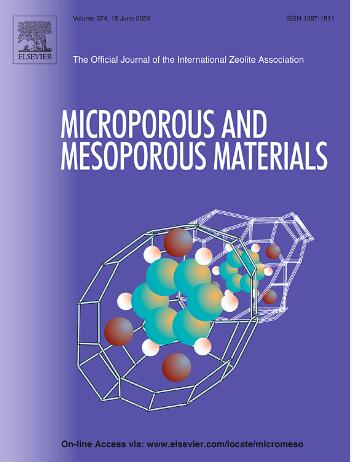On the hydrophobicity/hydrophilicity of hierarchically porous ZIFs
IF 4.8
3区 材料科学
Q1 CHEMISTRY, APPLIED
引用次数: 0
Abstract
Among MOFs, zeolitic imidazolate frameworks (ZIFs) are particularly notable for their zeolite-like structures and microporous properties, which are crucial for gas separation, catalytic activities, and energy applications. However, their microporous nature can hinder diffusion in certain applications. Recent efforts have focused on incorporating mesoporosity into ZIFs, enhancing their properties for diffusion-limited processes. This raises a question on the hydrophobicity/hydrophilicity of the formed mesoporosity, which is crucial for the applicability of such hierarchical MOFs in terms of their transport and chemical properties. In this study, we investigate the hydrophobicity/hydrophobicity of various hierarchical meso-microporous samples of ZIF-8 MOF (mZIF) by means of water intrusion-extrusion porosimetry. Different synthesis routes, precursor batches, and particle sizes were employed to evaluate the effects of mesoporosity on intrusion pressure, volume, and stability. The results reveal that while micropores of ZIF-8 maintain their hydrophobic nature, the mesopores are hydrophilic and are wetted by water spontaneously under ambient conditions. By this study, we demonstrate that the H2O intrusion-extrusion technique represents an accurate technique to independently access the hydrophobicity of hierarchical meso-microporous MOFs.

求助全文
约1分钟内获得全文
求助全文
来源期刊

Microporous and Mesoporous Materials
化学-材料科学:综合
CiteScore
10.70
自引率
5.80%
发文量
649
审稿时长
26 days
期刊介绍:
Microporous and Mesoporous Materials covers novel and significant aspects of porous solids classified as either microporous (pore size up to 2 nm) or mesoporous (pore size 2 to 50 nm). The porosity should have a specific impact on the material properties or application. Typical examples are zeolites and zeolite-like materials, pillared materials, clathrasils and clathrates, carbon molecular sieves, ordered mesoporous materials, organic/inorganic porous hybrid materials, or porous metal oxides. Both natural and synthetic porous materials are within the scope of the journal.
Topics which are particularly of interest include:
All aspects of natural microporous and mesoporous solids
The synthesis of crystalline or amorphous porous materials
The physico-chemical characterization of microporous and mesoporous solids, especially spectroscopic and microscopic
The modification of microporous and mesoporous solids, for example by ion exchange or solid-state reactions
All topics related to diffusion of mobile species in the pores of microporous and mesoporous materials
Adsorption (and other separation techniques) using microporous or mesoporous adsorbents
Catalysis by microporous and mesoporous materials
Host/guest interactions
Theoretical chemistry and modelling of host/guest interactions
All topics related to the application of microporous and mesoporous materials in industrial catalysis, separation technology, environmental protection, electrochemistry, membranes, sensors, optical devices, etc.
 求助内容:
求助内容: 应助结果提醒方式:
应助结果提醒方式:


